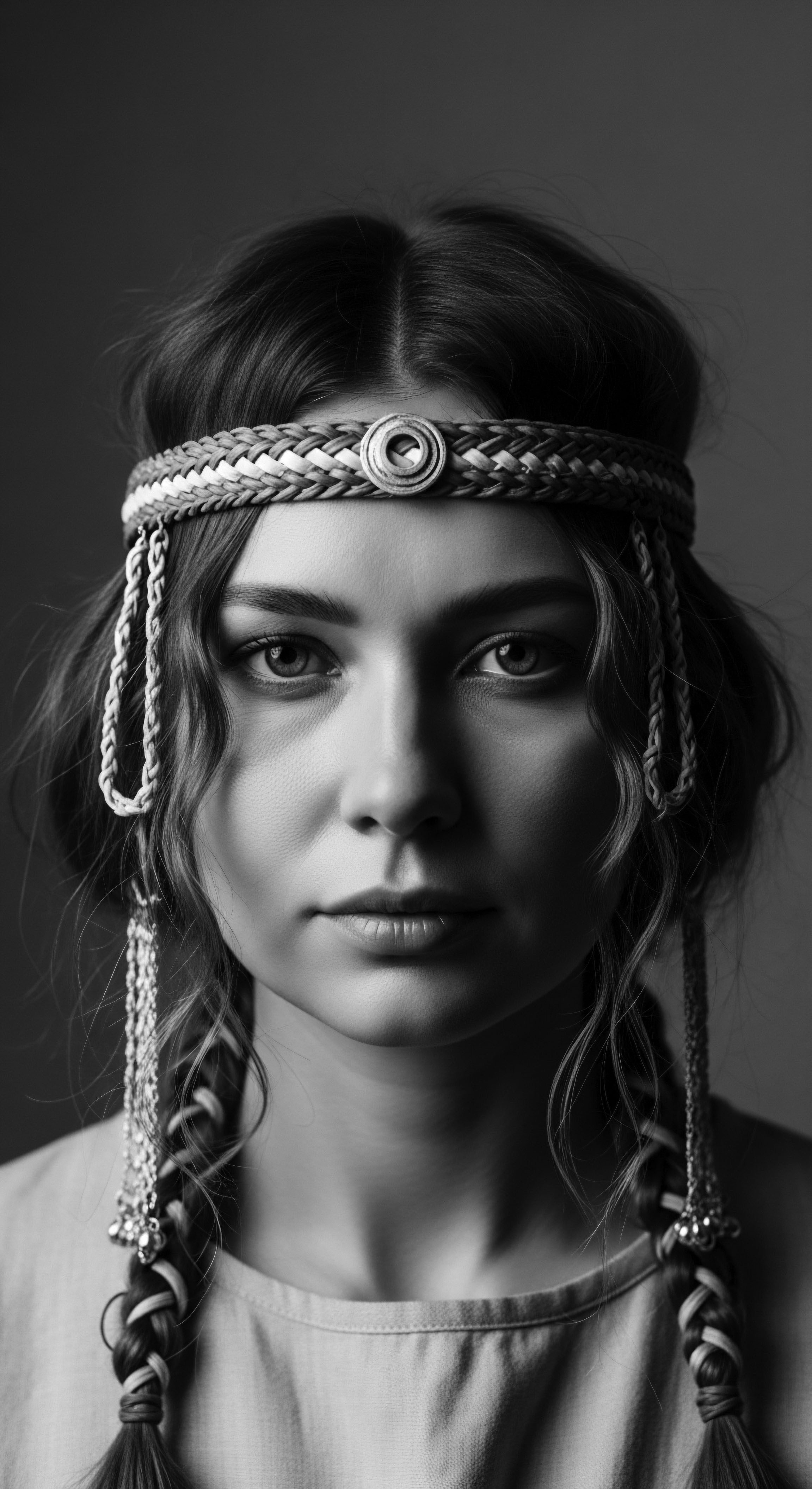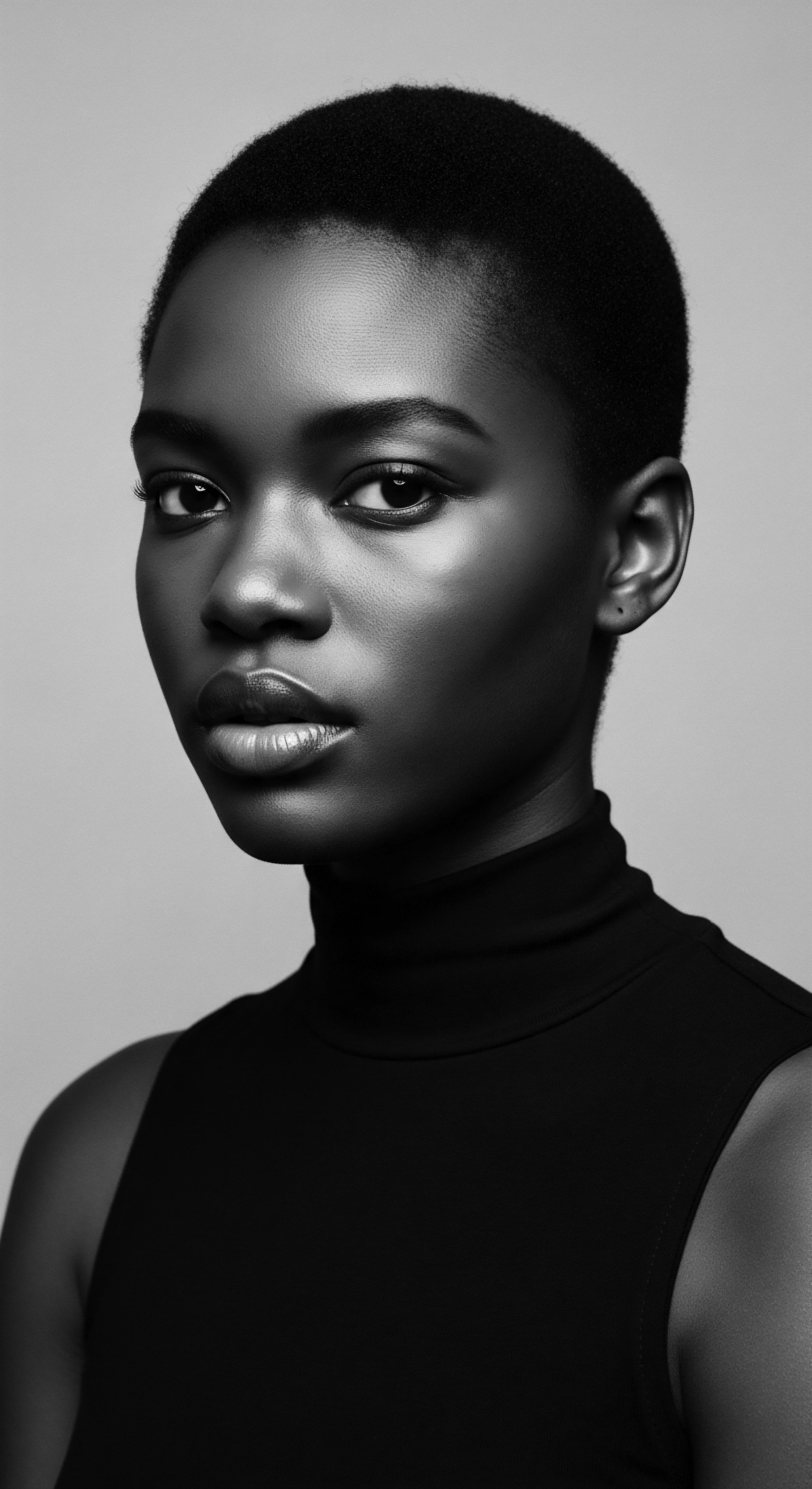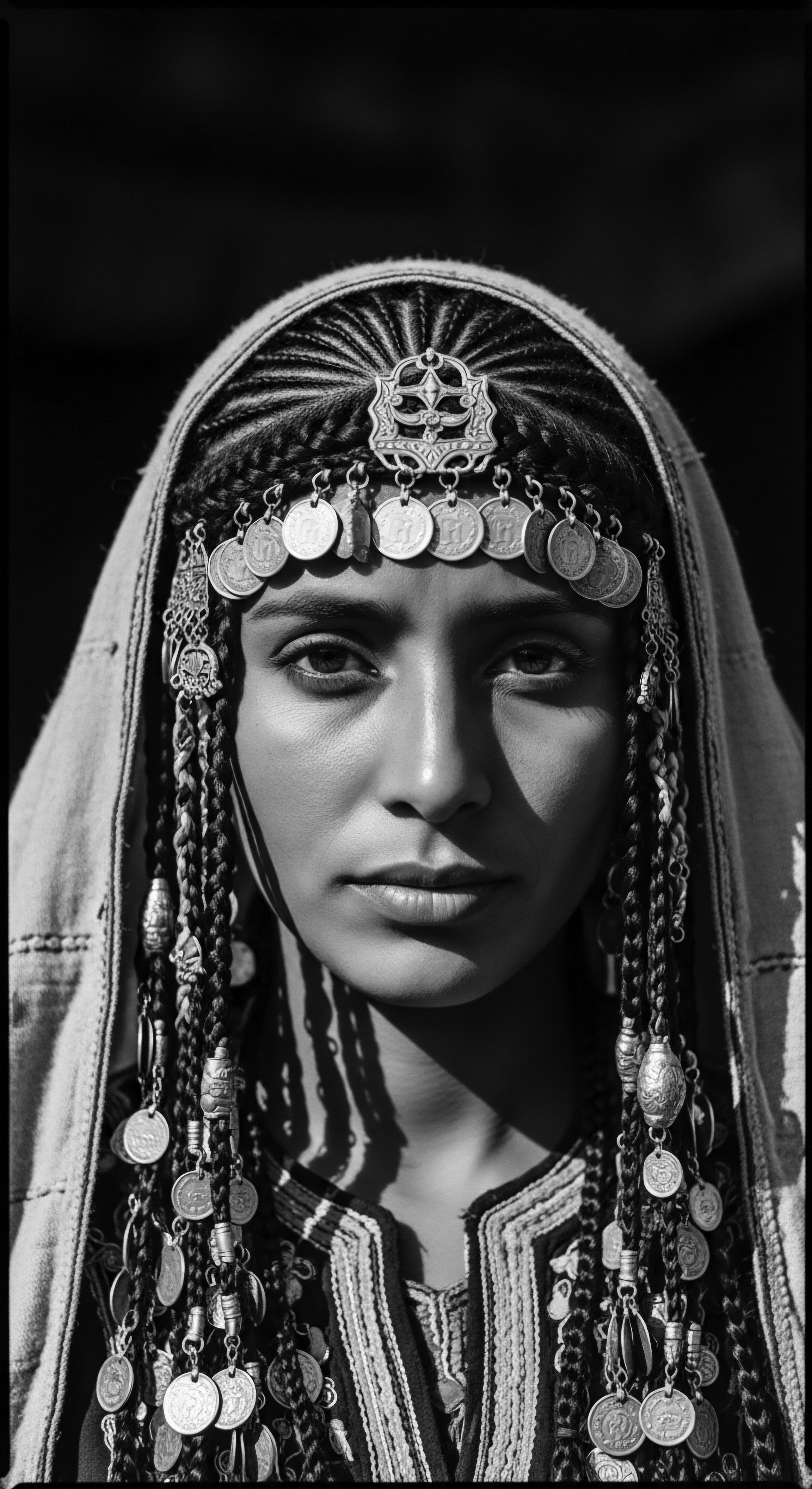
Roots
To stand before a strand of textured hair is to confront a living chronicle, a helix holding eons of wisdom within its very structure. For those whose lineage traces through the continents of Africa and beyond, hair is more than a mere biological extension. It is a conduit to ancestry, a testament to resilience, and a living map of heritage. This exploration considers the venerable ingredients, whispers from a distant past, that have served to sustain the intrinsic balance of moisture for our unique coils and kinks, ensuring their vitality across generations.
The inherent architecture of textured hair, with its elliptical shaft and numerous bends, presents distinct needs. These curvatures, while yielding glorious spirals and z-patterns, also present points where moisture can escape more readily, where friction can be a challenge. Ancient custodians of hair wisdom understood this fundamental truth, long before modern microscopes revealed the secrets of the cuticle. Their responses were not accidental; they were born from centuries of observation, experimentation, and a profound respect for the plant world and its offerings.

Anatomy of Ancestral Wisdom
The very essence of what textured hair requires for its well-being – consistent hydration and protective conditioning – was intuited by our forebears. They recognized the thirsty nature of highly coiled strands and sought out natural emollients and humectants from their immediate environments. This empirical knowledge, passed down through oral traditions and communal practices, formed the bedrock of hair care that prioritized the hair’s natural inclination towards dryness. The understanding of how particular plant extracts or natural fats interacted with hair, holding fast to precious water, became an essential skill, as vital as cultivating crops or preparing sustenance.
Ancestral practices reveal a deep, intuitive understanding of textured hair’s need for lasting moisture.
Consider the venerable Shea Butter, often spoken of as “women’s gold” across West Africa. Derived from the nuts of the shea tree (Vitellaria paradoxa), its preparation is a labor of love and community, often exclusively undertaken by women. The traditional method involves drying, crushing, and then boiling the nuts, extracting a rich, ivory-colored fat. This butter has served for centuries not only to shield skin from harsh sun and winds, but also to nourish and moisturize hair, providing a protective barrier against moisture loss (Ciafe, 2023).
Its bounty of fatty acids and vitamins A and E are not just beneficial; they are a legacy, a living link to the landscapes and livelihoods of our forebears (Seams Beauty, 2018). The Dagomba and Mamprusi communities in northern Ghana and southern Burkina Faso view the shea tree as sacred, sometimes prohibiting its felling out of respect for its significance (Natural Poland, 2025). This reverence underscores the deep connection between the ingredient and the cultural fabric.
Another ingredient, Moringa Oil, sometimes called the “miracle tree” or “tree of life,” hails from India and parts of Africa, including Ethiopia, Kenya, Nigeria, and Uganda (Natural Poland, 2023). Ancient Egyptians reportedly used moringa oil to safeguard their hair and skin from desert heat and winds, jars of it found in ancient tombs serve as silent witnesses to its esteemed place (Naturali, 2024), (Moringa Oil, n.d.). The oil, extracted from moringa seeds, is rich in proteins, amino acids, and essential fatty acids, making it a powerful moisturizer and scalp conditioner (Naturali, 2024). Its light yet profoundly nourishing qualities align with textured hair’s need for hydration without oppressive weight.
- Shea Butter ❉ A West African staple, traditionally processed for centuries, rich in fatty acids and vitamins A and E, providing lasting moisture and protection (Ciafe, 2023).
- Moringa Oil ❉ Revered across Africa and Asia, historically used by ancient Egyptians, offering nourishing properties to both scalp and hair (Naturali, 2024).
- Aloe Vera ❉ Used for over 5,000 years, its gel provides hydration and soothing properties to hair and scalp, a universal ancestral balm (Rene Furterer, n.d.).

How Ancestral Knowledge Explains Hair Needs?
The wisdom embedded in these practices predates modern scientific classification. While contemporary understanding breaks down hair into types (3A-4C, for example), ancient communities understood hair through its lived reality ❉ its tendency to tangle, its thirst, its breakage. They observed that tightly coiled hair was more prone to dryness and breakage, and developed care routines around this observation (MDEdge, 2020). This inherent fragility meant special care was needed, particularly when wet (MDEdge, 2020).
Their solutions were rooted in what was available in their environment and proven effective through generations of shared experience. The very act of washing less frequently and applying oils or butters for moisture retention, as practiced historically, aligns with modern recommendations for textured hair (MDEdge, 2020).
| Ancestral Ingredient Shea Butter |
| Traditional Use for Hair Applied to protect hair from sun, wind; used for softness and manageability (Ciafe, 2023). |
| Modern Scientific Link to Moisture Rich in fatty acids (oleic, stearic) which create a lipid barrier, minimizing transepidermal water loss from the hair shaft (Seams Beauty, 2018). |
| Ancestral Ingredient Moringa Oil |
| Traditional Use for Hair Protection against harsh elements; overall nourishment for hair and scalp (Naturali, 2024). |
| Modern Scientific Link to Moisture Contains oleic acid, which helps restore moisture levels and strengthens roots; vitamins A, C, E provide antioxidant benefits (Naturali, 2024), (Natural Poland, 2023). |
| Ancestral Ingredient Aloe Vera |
| Traditional Use for Hair Conditioning, soothing scalp, promoting growth (Rene Furterer, n.d.), (Carmesi, 2022). |
| Modern Scientific Link to Moisture Its gel forms a protective coating on hair fibers, reducing water evaporation; contains humectants that attract moisture to the hair (Rene Furterer, n.d.). |
| Ancestral Ingredient These ancient remedies, born from deep observation, are now understood through the lens of contemporary science, reinforcing their timeless effectiveness for hair's well-being. |

Ritual
The relationship with textured hair extends beyond its biological structure; it encompasses a vibrant world of tradition, ritual, and shared communal experience. Hair care was never a solitary chore. It was, and in many places remains, a collective endeavor, a time for bonding, storytelling, and the transmission of ancestral wisdom. These rituals were not only about physical cleansing and beautification; they were acts of cultural preservation, affirming identity even in the face of immense adversity.

Communal Connections and Sacred Practices
Across various African communities, hair braiding was not simply a style but also a communal activity, a time for mothers, daughters, and friends to gather, strengthening bonds while preserving cultural identity (TSPA Battle Creek, 2024). Such practices, often taking hours, allowed for the exchange of stories, songs, and the handing down of knowledge about traditional ingredients and their application (Expedition Subsahara, 2021). This collective memory is a powerful archive of hair care. The methods developed centuries ago provided a practical means of keeping hair manageable and protected, particularly under harsh conditions (Odele Beauty, 2024).
Hair rituals represent a profound connection to collective memory and cultural resilience.
From Chad, the Chebe Powder provides a compelling illustration of this communal and heritage-rich approach to hair care. Women of the Basara tribe have for centuries used a specific blend of indigenous herbs, including shébé seeds (from the Croton zambesicus plant), mahllaba soubiane seeds, missic stone, cloves, and samour resin (Chebeauty, 2023). This powder is traditionally mixed with water or oil to create a paste applied to the hair shaft, then braided, and left on until the next wash day. The women of Chad attribute their remarkable hair length, often reaching their waists, not merely to genetics, but to the moisture-retaining and breakage-preventing qualities of this unique preparation (Design Essentials, 2023).
This practice is a deep well of cultural value, extending beyond beauty to foster community and identity (SEVICH, n.d.). It stands as a powerful example of how localized ancestral knowledge directly addresses the specific challenges of textured hair in arid climates, ensuring sustained hydration and discouraging breakage (SEVICH, n.d.).
In North Africa, the use of Rhassoul Clay, extracted from the Atlas Mountains of Morocco, has been a ritualistic component of hair and skin care for thousands of years (Bioflore, n.d.), (Helenatur, 2020). This fine, silky clay is rich in silicon and magnesium, minerals that strengthen hair and scalp (Helenatur, 2020). Unlike modern shampoos that strip natural oils with surfactants, rhassoul clay cleanses by absorbing impurities and excess oil without disturbing the hair’s natural protective film (Bioflore, n.d.). It’s an essential part of the Hammam Tradition, a communal bathing ritual that speaks to holistic self-care and purification.
Rhassoul clay is so esteemed that it remains a part of the dowry offered to Moroccan brides, symbolizing its value in beauty and well-being (Helenatur, 2020), (Ghassoul, n.d.). Its gentle cleansing and mineral content directly address the needs of textured hair by purifying the scalp while respecting the hair’s delicate moisture balance.

How Did Hair Care Rituals Evolve Through History?
The journey of these rituals, particularly for people of African descent, was profoundly impacted by forced displacement. During the transatlantic slave trade, the deliberate shaving of heads upon arrival was a calculated act to strip enslaved Africans of their cultural identity and lineage (Library of Congress, n.d.), (MDEdge, 2023). Despite this systematic dehumanization and lack of access to traditional tools or products, the knowledge persisted. Enslaved people found ways to adapt, often using available materials like kerosene or even bacon grease when ancestral ingredients were inaccessible (Library of Congress, n.d.).
Braiding, for example, became a means of resistance, with patterns used to encode secret messages and maps for escape routes on the Underground Railroad (Odele Beauty, 2024), (Nationale Opera & Ballet, 2021). The communal practice of hair care on Sundays became a vital tradition, a moment of connection and cultural continuity for enslaved families (Library of Congress, n.d.). This adaptation speaks volumes about the enduring power of heritage.
The transition from traditional practices to adapting under duress, and later to the rise of Eurocentric beauty standards (MDEdge, 2023), shows the resilience of these ancestral practices. The “Natural Hair Movement” of the 2000s, for instance, marked a resurgence of pride in these ancestral textures and methods, rejecting chemical straighteners and embracing healthier care regimens (MDEdge, 2025). This movement, deeply rooted in the Civil Rights era’s Black is Beautiful ethos, championed self-definition and the reclamation of identity through hair (ClickOrlando.com, 2021).
- Chebe Powder ❉ An ancestral blend from Chad, traditionally mixed with oils to coat hair, preventing breakage and locking in moisture for remarkable length (Chebeauty, 2023).
- Rhassoul Clay ❉ A Moroccan mineral clay, used for thousands of years as a gentle cleanser that purifies the scalp and hair without stripping natural oils, enhancing natural moisture (Bioflore, n.d.).
- Ancestral Oils ❉ Palm oil, castor oil, and local plant-based oils were staples, providing lubrication and sealing moisture into strands, often used in hot oil treatments for hair health (MDEdge, 2025).

Relay
The passage of ancestral wisdom across generations is a vibrant, living relay, a continuous exchange of knowledge, technique, and spirit. It is within this relay that we find the deepest insights into textured hair’s moisture needs, linking ancient botanical understanding with contemporary scientific validation. This connection is not merely academic; it is a reaffirmation of the foresight and ingenuity inherent in practices passed down through time.

Botanical Allies in Moisture Retention
The meticulous selection of plant-based ingredients for hair care was not arbitrary. It was a careful process informed by keen observation of how these plants behaved in their natural environments. Take, for instance, Jojoba Oil. This liquid wax, derived from the seeds of a plant native to the southwestern United States and Northern Mexico, was a cherished element in Native American hair and skin care (Timeless Beauty Secrets, n.d.).
Jesuit missionaries in the 18th century documented Native Americans heating the seeds and grinding them into a buttery substance used for conditioning hair and skin (Afterglow Cosmetics, n.d.), (Timeless Beauty Secrets, n.d.). Modern chemistry now explains this historical efficacy ❉ Jojoba oil’s chemical composition closely mirrors that of human sebum, the natural oil produced by our scalp (Timeless Beauty Secrets, n.d.). This structural similarity allows it to smooth the hair’s cuticle, lock in moisture, and provide a gentle shield without feeling heavy, effectively balancing scalp oil production (Tyme, 2025). The O’odham tribe, who named the seeds “howhowi,” recognized its versatility, using it for hair and skin care (NuSkin, 2017), (PMC, n.d.). The use of jojoba oil by Indigenous peoples centuries ago speaks to their deep understanding of the environment and its gifts, a wisdom that modern science is only now catching up to (Tyme, 2025).
Another ancestral staple, Aloe Vera, has a documented history spanning over 5,000 years, revered across various cultures for its hydrating and soothing attributes (Rene Furterer, n.d.). Native American tribes and ancient Latin American civilizations, such as the Mayans and Aztecs, employed aloe vera gel as a natural conditioner to promote hair growth and calm scalp irritation (22 Ayur, n.d.). Its ability to form a protective coating on the hair fiber and its humectant properties, drawing moisture from the air, make it an exceptional agent for maintaining hydration in textured hair (Rene Furterer, n.d.). The enduring appeal of aloe vera, from ancient remedies to contemporary formulations, highlights its timeless effectiveness for hair health (Carmesi, 2022).

How Did Ancestral Knowledge Influence Hair Science?
The enduring power of ancestral ingredients and practices for textured hair care finds compelling validation in modern scientific understanding. The traditional emphasis on retaining moisture, for instance, aligns directly with the contemporary understanding of textured hair’s inherent dryness and susceptibility to breakage due to its unique coiled structure (MDEdge, 2025). Afro-textured hair, specifically types 4A-4C, often experiences significant dryness and brittleness (MDEdge, 2025).
Ancient practices, such as the use of oils and butters, and regimens like the “Liquid, Oil, Cream” (LOC) or “Liquid, Cream, Oil” (LCO) methods, which use water, a chosen oil, and a cream (like shea butter) to seal in hydration, are now widely recognized as effective strategies (MDEdge, 2025), (MDEdge, 2020). These techniques are not new inventions; they are direct descendants of ancestral wisdom adapted for modern contexts.
A statistical insight into the modern adoption of natural hair care further illuminates this heritage connection. While specific comprehensive statistics on ancestral ingredient efficacy across all Black and mixed-race populations can be complex to isolate due to the diversity of practices, recent trends speak volumes. For instance, in the United States, it is estimated that between 30% and 70% of Black women wear natural hair, a figure that rises to 79% for millennial Black women under 30 years old (MDEdge, 2025).
This significant shift away from chemical straighteners, which gained popularity during periods of Eurocentric beauty pressure, signals a broad cultural movement towards embracing natural texture and, by extension, a renewed interest in ingredients and methods that support its health. This resurgence is a direct acknowledgement of ancestral pathways to care, validating the effectiveness of ingredients like shea butter and the moisture-retention principles they embody (MDEdge, 2025).
| Aspect of Hair Care Moisture Sealing |
| Ancestral Practice / Ingredient Regular application of shea butter and other plant oils (MDEdge, 2025). |
| Modern Parallel / Scientific Validation LOC/LCO methods that layer liquid, oil, and cream to retain hydration in coiled hair (MDEdge, 2025). |
| Aspect of Hair Care Cleansing & Scalp Health |
| Ancestral Practice / Ingredient Use of rhassoul clay, which cleanses by absorption without stripping natural oils (Bioflore, n.d.). |
| Modern Parallel / Scientific Validation Sulfate-free shampoos and co-washing techniques designed to preserve hair's natural moisture barrier. |
| Aspect of Hair Care Breakage Prevention |
| Ancestral Practice / Ingredient Chebe powder used by Basara women to fortify strands and reduce friction (SEVICH, n.d.). |
| Modern Parallel / Scientific Validation Protein treatments and conditioning agents that strengthen the hair shaft, reducing fragility (MDEdge, 2020). |
| Aspect of Hair Care The enduring wisdom of ancestral practices continues to shape contemporary hair care, offering profound guidance for maintaining hair health. |

What Does Heritage Teach About Hair Resilience?
The journey of textured hair through history is a powerful narrative of resilience, deeply intertwined with ancestral ingredients and practices. From the forced head shavings during slavery, a deliberate act of dehumanization (Library of Congress, n.d.), (MDEdge, 2023), to the demonization of Afro hair as “unprofessional” (CurlyTreats, 2025), the very texture of Black and mixed-race hair has been a site of struggle. Despite this, the knowledge of care persisted, often through clandestine means. Braiding, a practice dating back thousands of years in Africa, used to convey social status, age, and tribal affiliation, became a vital act of cultural preservation and communication during slavery (Odele Beauty, 2024), (Nationale Opera & Ballet, 2021), (Expedition Subsahara, 2021).
The strength of hair, both literally and symbolically, mirrors the strength of a people. Ancestral ingredients, through their consistent use, contributed not only to the physical health of the hair but also to the preservation of identity and spirit.
The ongoing return to these traditional ingredients and methods is not just a trend; it is a profound reclamation. It speaks to a desire to connect with and honor the lineage of care that was once suppressed. This conscious choice to align with ancestral wisdom for managing textured hair’s moisture is a testament to the enduring power of heritage, proving that the deepest roots are not easily severed.

Reflection
The journey through ancestral ingredients, from the deep roots of biological understanding to the tender threads of communal rituals and the far-reaching relays of knowledge, reveals a truth profound and enduring ❉ textured hair carries the echoes of countless generations. Its vitality is intrinsically linked to the wisdom of those who came before us, a wisdom woven into the very fabric of identity and collective memory. The oils, butters, and clays are not simply substances; they are remnants of a sacred relationship with the earth, whispers of resilience against harsh climates and even harsher historical forces.
Roothea’s Soul of a Strand ethos recognizes this continuum. Our coils and curls, each with its unique pattern and thirst, are a living archive. When we apply shea butter, we are not just moisturizing; we are participating in a timeless ritual, connecting to the hands of West African women who centuries ago harvested and processed this very resource.
When we use rhassoul clay, we are invoking practices from North Africa, honoring a tradition that saw cleansing as an act of purification, both physical and spiritual. These ingredients, in their elemental power and historical weight, remind us that the finest care for our hair is often found not in fleeting trends, but in the enduring legacy of our ancestors.
The path forward for textured hair care is one of respectful remembrance. It involves acknowledging the ingenuity of those who first understood the unique needs of coiled strands and identified the plants that could meet them. It means understanding that moisture balance is not a modern scientific discovery, but an ancestral challenge met with ingenuity and communal love. This connection to heritage strengthens us, allowing our hair to stand not just as a crown of beauty, but as a vibrant, living testament to the unbroken chain of wisdom passed down, strand by precious strand.

References
- 22 Ayur. (n.d.). The Ancient Natural Ways of Hair Care Across Continents.
- Afterglow Cosmetics. (n.d.). Jojoba Oil For Natural Beauty.
- Bioflore. (n.d.). Ultra fine grey rhassoul for washing hair and skin naturally.
- Carmesi. (2022, May 19). 7 Ancient Ways To Wash And Condition Your Hair.
- Chebeauty. (2023, August 10). How To Use Chebe Powder For Hair Growth.
- Ciafe. (2023, January 31). Discovering the Origins of Shea Butter – A Journey to the Heart of Africa.
- ClickOrlando.com. (2021, January 18). From hot combs to hair grease ❉ The journey behind afro-textured hair in America.
- CurlyTreats. (2025, February 8). Afro comb ❉ the cultural and political legacy behind this iconic hair tool.
- Design Essentials. (2023, March 6). Journey to Chad ❉ The Origin of Chebe Powder & the Design Essentials African Chebe Growth Collection . YouTube.
- Expedition Subsahara. (2021, October 22). Interwoven down through the generations.
- GirlsOnTops. (2020, August 31). A Sacred Legacy ❉ On Black Hair And The Revolutionary Power of Self-Exp.
- Ghassoul. (n.d.). Ghassoul (Rhassoul) Clay ❉ Origin & History Of This Amazing Wonder!
- Helenatur. (2020, March 5). Rhassoul clay.
- Library of Congress. (n.d.). Heavy is the Head ❉ Evolution of African Hair in America from the 17th c. to the 20th c.
- MDEdge. (2020). Historical Perspectives on Hair Care and Common Styling Practices in Black Women.
- MDEdge. (2023, November 30). What Every Dermatologist Must Know About the History of Black Hair.
- MDEdge. (2025, March 4). Historical Perspectives on Hair Care and Common Styling Practices in Black Women.
- Naturali. (2024, July 4). Moringa Oil 101 ❉ Everything You Need To Know About Liquid Gold.
- Natural Poland. (2023, May 9). Moringa Oil in Africa ❉ Harnessing a Miraculous Superfood for Nutrition, Skincare, and Wellness.
- Natural Poland. (2025, April 17). In the Shea Belt ❉ How Ghana and Burkina Faso Became the Heart of a Global Ingredient.
- Nationale Opera & Ballet. (2021, October 22). Interwoven down through the generations.
- NuSkin. (2017, September 11). Jojoba Oil ❉ An Updated Comprehensive Review on Chemistry, Pharmaceutical Uses, and Toxicity.
- Odele Beauty. (2024, January 16). A History Lesson On Hair Braiding.
- PMC. (n.d.). Jojoba Oil ❉ An Updated Comprehensive Review on Chemistry, Pharmaceutical Uses, and Toxicity.
- Rene Furterer. (n.d.). Hair and scalp care with aloe vera ❉ the benefits.
- SEAMS Beauty. (2018, January 8). The History Of Shea Butter.
- Sellox Blog. (2021, June 4). Ancient African Hair Growth Secrets For Healthy Hair.
- SEVICH. (n.d.). The Cultural Background and History of Chebe Powder.
- Timeless Beauty Secrets. (n.d.). Native American Jojoba Oil.
- TSPA Battle Creek. (2024, February 27). The Enduring Influence of Black Culture on the Cosmetology Industry.
- Tyme. (2025, April 30). Why jojoba oil for hair is blowing up (again).
